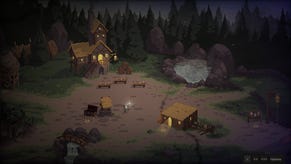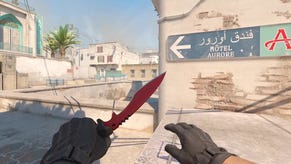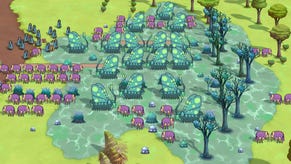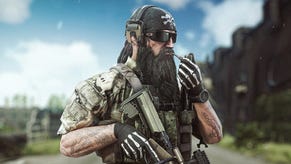John Nation: A Yank In The (Virtual) RAF
I can pepper my flight sim reviews with as much talk of retreating blade stalls, snap rolls and skip bombing as I like, but until I get round to building a simpit and joining a virtual combat squadron, my hardcore flight simmer credentials will always look a tad suspect. John Nation, a chap I've been swapping emails with for a while, is the real deal. In the Q&A that follows, he waxes lyrical on a range of subjects including his splendid Spitfire-shaped sim throne, long career with the Tangmere Pilots and ambitious Ultimate Goal.
John, where did your interest in flight simulation spring from?
From actual flight itself. I've wanted to fly since I was five years old.
My first memory of an airplane was in the summer of 1950 when I was a farm kid living in cowboy country, southern Oklahoma. My Uncle John, my namesake, had returned from 4 years on a minesweeper in the Pacific during the war and was learning to fly on the GI Bill. The primary trainer of the day was a canary yellow 65 hp J-3 Piper Cub and Uncle John's plane was no different. One hot summer day while all the women of the place - my grandmother, my mother, and Aunt Freddy - were canning garden vegetables on a giant wood burning stove that we kept outside during the summer, just for the purpose, I heard a buzzing sound off to the north and spotted a small yellow dot winging its way through the sky. I ran out on the hard-packed red clay beyond the shade of the four giant elm trees where we literally lived during the heat of the summer. The small yellow dot rapidly turned into a yellow airplane that flew low over our two storey farm house - so low I thought it might impale itself on the lightning rod that formed a sort of skinny steeple on the roof.
"It's Uncle John!" I yelled to the ladies, who put down their tongs and lids to come see what was happening in the blue summer sky. My grandmother, a stoical prairie woman who had no use for modern inventions simply looked at her son and his airplane doing Figure 8 turns over the house, wiped her hands on her apron, and said, "That fool son of mine is going to kill himself in that fool airplane."
At 14, earning 25 cents an hour from farm labor, I saved the ten dollars for a flight in what was likely the same J3 Cub. I hitchhiked the ten miles to the airport, paid my money, buzzed around, but later realized I hadn't learned a thing. Summer ended and school began before I could earn another ten dollars. That was pretty much the story of my experiences in real aviation from then on. I'd get some money, go flying, but before I could get my license, the money would run out. (I didn't get my Pilot's License until 1997, when I was 53 years old.)
Now, about Flight Simulation. I was always doing it I think. If you saw the movie Pearl Harbor there is a scene early on when the two boys build a make-believe warplane from the wreck of an old biplane. That was my brother Monty and me. He being two-years younger, I'd get us in trouble, he's get us out. The same pattern applies today.
Once we made a parachute from a carpet square with a rope at each corner. We tied the ropes together under his arm pits, and climbed a tree. "You're so close to the ground, you won't have time for the chute to open. So throw it up in the air and jump under it and it'll let you down real easy.". The carpet weighed about twenty pounds. Monty tossed it up and out, as per instruction, and the weight jerked him out of the tree where he came to a soft landing on top the carpet. I considered the whole idea a success though we obviously needed a better parachute. Monty seemed to lose interest in the parachute project though.
By the time we were 12 and 10 respectively, we had moved north to a small community near Tinker Air Force Base close to Oklahoma City. We had airplanes overhead all the time - big ones like the B-36 that made the ground rumble, and little ones like the F-86 Sabre jets.

One advantage of being near an air base was the availability of old airplane parts at kids' prices. Monty and I bought a mint P-51 Mustang armored windscreen for five dollars. To see if the armor worked we shot it.
It worked.
Oxygen masks in the box for a quarter.... a huge B-47 canopy that we tied a rope to, turned upside down, and drug like a toboggan across the prairie behind one of our horses, one of us or a friend inside whooping it up as it scooted across the grass...
And during all of this, I made airplanes, and airplane cockpits of anything I could find. I cut holes in cardboard boxes and pasted home-made instruments behind the holes and then stuck one of our mother's lamps in it so we could do night flying. A vacuum cleaner electric motor made a nice jet whine; flip a switch and up she started. I made full sized rubber band powered airplanes that never flew, big enough to sit in, with a ten foot long rubber band made by looping together slices of automobile inner tubes. About two minutes of winding would give about fifteen seconds of a turning prop.
I worked on the problem of how to get some scenery of some kind to move under and behind my cockpits. This was about 1958, '59, '60, and I never came up with anything. Then puberty struck and suddenly the ickiest creatures on the planet looked mysterious and alluring. At that point I largely left airplanes behind. In my mid-twenties, I built a sailboat - another story - and sailed off to the islands for 20 years.
By the time I got back, something had been invented that allowed the realization of all those childhood dreams of flying. With a computer, a flight simulator and a cheap flight stick, one could pretty well live the vision I'd had forty years before.
I know you cut your PC flight sim teeth on Jane's WWII Fighters and Microsoft CFS, before discovering the wonders of IL-2. How did you end up flying IL-2 with virtual RAF outfit The Tangmere Pilots?
I wanted to fly Spitfires online but initially, as there weren't any British planes in the sim, I joined a US-based Luftwaffe Squadron and played with them for a year or so. It was a great experience, and I loved the Me109. When the IL-2 series was updated to include a Hurricane and some other British aircraft, I started looking about for a virtual RAF Group. That was when I fell in with the Tangmere Pilots.
After applying and filling out some info sheets, I was set up to fly four assessment flights a week apart at No 6 OTU. I was given a Hurricane Mk 1 training skin, and away I went with F/L "Tom" who would later be my CO. The assessment flights were basically to determine flying competence (the TPs don't teach you how to fly) and to check out 'team spirit', the ability to fly harmoniously with a very diverse group of pilots. There were TPs not only from England and the US, but from France, Belgium and the Ukraine. Like the real Royal Air Force, we're a very international bunch.
I passed my assessment flights and was posted to 601 Squadron (there are 3 squadrons: 1, 145, and 601) flying Green 3 in Malta, under S/L Bigbyte. Tom, my training instructor, was B Flight leader, and later took over the helm of 601, when Bigbyte, who was real RAF, was sent to Afghanistan. I proceeded to get shot down at a rather alarming rate, every now and then scoring a kill of my own. This was all distressingly realistic.
The TP always fly historically accurate missions based on real missions in real WW2 campaigns. So I was learning things about the RAF Fighter Pilot's war first hand.
As the years went by (now five of them) I flew many planes in many campaigns. Medals eluded me but I did get an MID (Mentioned In Dispatches) for shooting down the first LW jet Me262 of the Campaign in my Spit IX, RR232.
Like all wars, the TP's WW2 eventually ended, in our case with a Pacific Royal Navy Campaign flying Corsairs and Seafires. Since we're a WW2 sim group only, and Storm of War: Battle of Britain still hadn't arrived, the TPs simply decided to to start the war all over again - in Gladiators in Norway. Currently we're flying Hurris in the Battle of France. Once more I am waiting for my first Spitfire - a lovely Mark 1 I hope.
Talking of Spits, I gather you have one in your basement.
There are actually two different Spitfires in 'The Dungeon'. One is a flying (hopefully) replica with wings, tail etc. The other - the one I use for simming and take to airshows - is a cockpit section incorporating Jon Fellows' superb SpitSim controls and a 27 inch monitor.
How do you go about building something like that?
I got the plans from a book called 'The Spitfire Mark IX Engineered' . I simply drew full sized patterns onto thin birch plywood then cut the patterns to shape with a jig saw. Eventually I intend to add a working canopy on sliders, so I've fitted six fuselage formers to support this. The former forward of the instrument panel also provides support for the monitor shelf, while the aft ones supports a platform for the computer, making everything self contained.
The formers are inserted in a plywood base (fitted with castoring wheels for easy movement) and tied together with stringers. I made my own pilot's seat out of aluminium and used commercial spray cans to paint the interior (a locally available shade called 'sage' which is a reasonable imitation of primer green). The exterior will be painted a brown and green Battle of Britain Mk1 Spitfire scheme.
One thing I hadn't anticipated was just how hard it would be to enter the simpit! I consider climbing in and out my daily exercise regime and now fully understand Churchill's reference to RAF pilots as "those keen-eyed, slim hipped, young men."
How does sitting in a solid slice of Spitfire enrich your simming?
Flying a high performance plane, especially a high performance tail dragger like a Spitfire, calls for instantaneous, and automatic reflexes. At the speeds these airplanes fly, it is not always possible to take your eyes off the view ahead and look down into a dark cockpit and fumble around for, say, a flap or landing gear lever. These things have to come to hand from familiarity - which is why they used to give pilots blindfold checks before flying a plane for the first time.
This, for me, with my designs on someday flying a real Spitfire, is what a simpit provides - a safe way to attain the cockpit and handling knowledge of a particular airplane.
But I am likely an extreme case. Most simpit creators don't have the ambition, or perhaps the financial means, to fly the real plane of their dreams. They are building purely for immersion - something that I'm also hungry for. I like to think of myself as well and truly immersed.
Does the immersion bring insights? Do you think sims can also help us to understand the technical challenges and emotional/psychological aspects of aerial warfare?
Very definitely. At the emotional level, one only has to consider the stomach butterflies that every new combat sim pilot feels on his first mission. A member of a Luftwaffe squad I know has been flying for two years and still gets nervous before take-offs. Once airborne the butterflies vanish. Very reminiscent of real life air combat.
Then there's the new pilot's first debrief. When asked how it went, they'll invariably say, "I never believed anything could be so chaotic. I never knew what was happening, or even where I was."
Squadron Leaders have been shot down by nervous newcomers - I saw it happen twice. No fatalities, just a smoking engine and a hurried trip back to the base.
At the other end of the emotional spectrum is the elation of having flown a good mission - of having shot an enemy plane down. There is something extremely primitive, but very satisfying, in knocking an enemy from the skies, whether that sky is made of nitrogen and oxygen, or pixels.
The technical revelations are equally valid I feel. The adage that altitude and airspeed are the most important factors in a successful combat, is as true for virtual combat as for real combat. Get 'low and slow' and you're dead.
Most of my missions have been flown in B Flight, Green Section, where I am often 'Tail-end Charlie'. I actually like this as usually the squad will get bounced from the front. The back of the formation tends to be at a higher altitude than the leaders - a plus. Also, Green Section is most often left aloft to provide 'top cover' when the rest of the squad dives down to attack. My philosophy is simply to find the highest flying enemy plane I can and go for him. If I don't get him, I have at least kept the pilot's attention fixed on me and away from the other members of my squadron.
One learns very quickly the truth in the old maxim, "Never follow a wounded plane down". Very likely in virtual combat as in real combat, he has a buddy about, and, even if he hasn't, you'll lose so much altitude that you are effectively out of the fight for the rest of the sortie. Kill claim confirmation is what intel officers are for.
One develops personal idiosyncrasies. When flying a cannon and MG armed Spit, or the like, once the big rounds are gone, I horde my little bullets for the ride home. You'd be surprised how many times there's an Me109 loitering over the home base to polish off planes with empty guns. A few bursts will often send the fellow packing. I always try to land with ammo still in the magazines.
A lot of serious simmers seem to form deep attachments with particular planes and air forces. Why do you fly for the RAF and how come the Spit is so dear to you?
For reasons I know not, I am fascinated by England in the years 1938 to 1943. Hurricanes and Spitfires flying in formation move me to tears (which I discovered in Duxford at the 2000 Battle of Britain 60th Aniniversary Air Show). The final two years of the war? Too brutal, none of the rare instances of chivalry that existed early on on both sides.
The Spitfire itself has been called the world's most beautiful airplane, and that is I think a just claim. But whether or not it's true, it is the world's most important airplane. Had it not existed - and it almost didn't - the history of the second half of the Twentieth Century would likely be far different. It was the only Allied plane that could take on the German Me109 on equal terms. The Hurricanes destroyed more enemy planes in the Battle of Britain, but if the Spitfires, with their superior speed, had not been there to take the heat off from the 109s, the Hurris would have never gotten close to the bombers.
I chose the RAF because they have the Spitfires, and because I love English humor (though I don't always understand it). Also the RAF was famous for tolerating eccentrics, which helps in my case.
If someone stuck you in a real Spit and told you to take off, how do you think you'd get on?
I'd get on marvellously! With two caveats: first, I'd need to do a few practise landings from the backseat of a real Harvard trainer. This is is standard modern pre-Spitfire solo preparation. Second, I'd need a virtual Spitfire with accurate brake simulation. Current virtual Spits all behave on the ground as if they had steerable tailwheels. The truth is, no Spitfire ever had anything but a freely castoring tailwheel. This makes it easier for the majority of flight sim pilots to get their plane off the ground, but gives a false sense of actual ground handling. Under 40mph or so, because of the Spitfire's small rudder, all steering must be done by the differential brakes operated by a lever on the spade grip. Familiarity with this type of braking would be, to me, an essential part of training to fly a real Spitfire.
The fact that the Battle of Britain Memorial Flight Squadron Leader has tried SpitSim (the core of my simpit) and declared it "the nearest to flying a real Spitfire I have ever experienced" gives me confidence that I could make the transition fairly painlessly. 'Piece of cake' as the RAF say.
It looks like the long wait for BoB: Storm of War may soon be over. Are there particular things you're hoping to see implemented? IL-2 flaws you're hoping won't reappear?
The Tangmere Pilots have been abuzz about this since it was first announced. We have all watched the development teasers with a sort of morbid fascination - wanting it to get here, but trying to figure how to cope is for some reason we found it was cancelled.
Now that it seems that the balloon is about to go up, I sense a nervous renewal of energy. Some pilots are making virtual cockpits to enhance the experience, nearly all are wondering if their machine is up to snuff. There's a wonderful sense that 'the battle is about to be joined'.
This may sound silly, but working windsocks are high on my wish-list. The airfields used during the Battle of Britain were usually just large grassy pastures with a perimeter track around them. You could land in any direction. Just look at the sock and set up the approach so as to flare directly into the incoming wind. Spitfires do not like crosswinds.
I'm also hoping for radar and a virtual plotting board. I would like to see it arranged so one player could be the designated Radar Controller and vector interceptions via radio. Among the wives of the Tangmere Pilots there are number of lovely English-accented female voices that would be perfect for controller duty. I don't see how a real idea of the battle can be communicated without features like these, regardless of how stunning the game is from the cockpit.
IL-2 attributes I'd like to see modified? Better maps, allowing prototypical navigation. Pre-stall judder on the Mk I Spitfire. Oh, and a reality based kill verification system - no more instant "Enemy Plane Destroyed" messages.
Thanks for your time John. Bag an Me109 for RPS next time you're aloft.




















